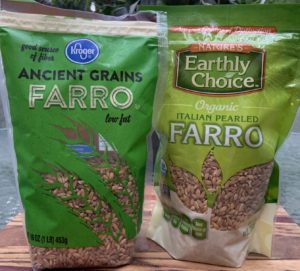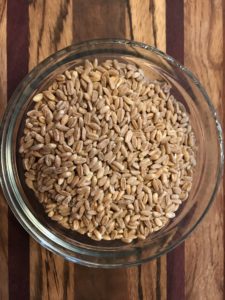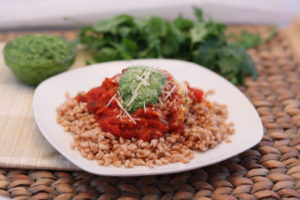You are probably intimately familiar with quinoa, which has exploded in popularity in the past few years. And, quinoa is loaded with nutrients and is a versatile addition to so many recipes, but there is another “ancient grain” gaining popularity more and more…
…FARRO!
(Pronounced FAR-oh, or you may hear some pronounce it FAIR-oh).
Just in case you haven’t heard of farro, or haven’t had the chance to try it, we want to introduce you to this up-and-coming whole grain! We have even been told, “I am not crazy about quinoa, but I LOVE farro!”
Where does farro come from?
Farro is an ancient grain that originated in western Asia, and has even been found in tombs of Egyptian kings.
Italians have enjoyed farro for centuries, using it in a wide variety of rustic dishes. Farro is Italian for “ancient wheat grain” and is actually used to describe three different grains: einkorn, emmer and spelt. In the U.S., the grain that you are most like to find is the emmer wheat.
Why eat farro?
 It is high in cholesterol-lowering fiber and is a good source of iron and protein.
It is high in cholesterol-lowering fiber and is a good source of iron and protein.- Nutritionally, it’s similar to quinoa. Pairing farro with beans, legumes or other proteins makes it a “complete” source of protein. For those with celiac or gluten sensitivities, please keep in mind that farro is NOT gluten-free!
- It’s a great source of complex carbs, which take longer to digest and will keep your energy levels stable. Just so you know, complex carbs are a staple in the diets of people who live to 100!
- It’s delicious! We love its nutty flavor and a slightly chewy texture…and it is easy to use in a variety of great-tasting meals! Many chefs are now using farro in their restaurants for exactly these reasons!
What are the different types of farro?
When you are buying farro, it will help to know there are three types:
- Whole: the grain is fully in-tact and all of the grain’s nutrients are retained. Some say whole farro has the most intense flavor, but soaking overnight is recommended.
- Semi-pearled: part of the bran has been removed. It still retains most of the nutrients and fiber and cooks faster than whole farro.
- Pearled: has no bran at all so it cooks the fastest.
 Farro is becoming more widely available in many grocery stores. One thing to keep in mind…it may not be entirely clear whether the farro you are buying is whole, semi-pearled or pearled.
Farro is becoming more widely available in many grocery stores. One thing to keep in mind…it may not be entirely clear whether the farro you are buying is whole, semi-pearled or pearled.
We recently bought a bag simply labeled as “farro” and we could not tell what type it was. (When all else fails, this is when the directions come in handy!). The directions told us to either soak it overnight and then cook (about 20-25 minutes) or, without soaking, to cook for 30-40 minutes. We did not soak it and it was perfectly tender after simmering for about 30 minutes.
Cooking with farro!
Farro is easy to prepare, just like other whole grains. One cup of dry farro makes about two to three cups cooked. To cook 1 cup of farro, use 3 cups of liquid (water or broth)…simply bring to a boil, and then simmer about 15 to 20 minutes for pearled or semi-pearled and 30-40 minutes for whole farro.
Our best tip! We like to tell people to cook farro like you would cook pasta. Unlike rice or quinoa, farro may not absorb all of the water…once it is tender, you can drain the excess water just like you do when cooking pasta. You want it to be tender and have an al-dente chewiness to it — you don’t want it to be mushy.
Some recommend soaking the farro overnight, and then it is easier and quicker to get it to “al dente” the next day. This isn’t anything fancy – we are just talking about pouring a couple of cups of water over the farro in a bowl — the hardest part is remembering to do it! If you soaked the farro overnight, the cooking time will be much shorter (as short as 10 minutes). Honestly, we rarely do this. For the farro we use, we just cook it on the stove for 15 to 20 minutes, and then taste it to make sure it has reached our desired tenderness and consistency.
How to enjoy it?
- You can cook a batch of farro and use it all week!
- It is excellent to use in salads, risotto, soups, breakfasts, and even desserts!
- Use it in place of barley, quinoa or rice! It’s very versatile!
 With summer produce right around the corner, a couple of our favorites include the Summer Farro Salad (which works great for lunch on the go or to take to summer get-togethers) and the Nectarine & Cherry Farro Salad (fantastic combination of summer flavors)!
With summer produce right around the corner, a couple of our favorites include the Summer Farro Salad (which works great for lunch on the go or to take to summer get-togethers) and the Nectarine & Cherry Farro Salad (fantastic combination of summer flavors)!
Some other great-tasting ideas include:
- One Pot Farro with Tomatoes
- Farro Green Olive Salad
- Chermoula-Inspired Spice Roasted Vegetables & Chickpeas
- Orange Farro Salad with Spring Veggies
- Baked Pesto Chicken Parmesan
- Black Eyed Peas and Veggie Curry
 Spring Asparagus Farro Salad
Spring Asparagus Farro Salad- Blackened Chicken with Mango & Chimichurri
- Roasted Broccoli and Farro Salad
- Slow Cooker Chipotle Veggie Chili
- Kale & Asparagus Farro Salad
- Autumn Minestrone Soup
The next time you are at the store, pick up some farro and give it a try – just another great way to get out of the box!
Please let us know what you think!
 LEARN MORE ABOUT THE NAPKIN!
LEARN MORE ABOUT THE NAPKIN!

 It is high in
It is high in 
We definitely are fans of farro! Thank you for this article and the list of recipe suggestions.
You are so welcome – farro is definitely a favorite of ours and trust us, you can’t go wrong with the Summer Farro Salad! 🙂
We had never heard of farro until we started Eat Real and now we enjoy it! Just ate Spring Asparagus Farro Salad-Yum 🙂
Thank you! You need to add the Summer Farro Salad to your list – we will be making it again soon with juicy summer cherry tomatoes!